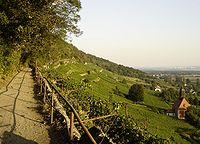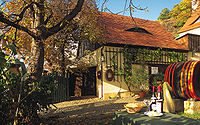
Saxony (wine region)
Encyclopedia


German wine
German wine is primarily produced in the west of Germany, along the river Rhine and its tributaries, with the oldest plantations going back to the Roman era. Approximately 60 percent of the German wine production is situated in the federal state of Rhineland-Palatinate, where 6 of the 13 regions ...
located in the German
Germany
Germany , officially the Federal Republic of Germany , is a federal parliamentary republic in Europe. The country consists of 16 states while the capital and largest city is Berlin. Germany covers an area of 357,021 km2 and has a largely temperate seasonal climate...
federal state of Saxony
Saxony
The Free State of Saxony is a landlocked state of Germany, contingent with Brandenburg, Saxony Anhalt, Thuringia, Bavaria, the Czech Republic and Poland. It is the tenth-largest German state in area, with of Germany's sixteen states....
. The region is sometimes referred to colloquially as the Elbtal (Elbe valley). The wine region covers 462 hectares (1,141.6 acre), which makes it Germany's third smallest region, just ahead of Mittelrhein
Mittelrhein (wine region)
Mittelrhein is a region for quality wine in Germany, and is located along a 120 km stretch of river Rhine in the touristic portions of the Rhine region known as Middle Rhine. On the left bank of Rhine, vineyards begin immediately downstream of the Nahe River estuary and last until Koblenz...
and Hessische Bergstraße in size. It is situated along the Elbe
Elbe
The Elbe is one of the major rivers of Central Europe. It rises in the Krkonoše Mountains of the northwestern Czech Republic before traversing much of Bohemia , then Germany and flowing into the North Sea at Cuxhaven, 110 km northwest of Hamburg...
river from the Pillnitz
Pillnitz
Pillnitz is a city quarter in the east of Dresden, Germany. The quarter is situated in the east of Dresden. It can be reached by bus, ship, walking along the river or by bicycle...
section of Dresden
Dresden
Dresden is the capital city of the Free State of Saxony in Germany. It is situated in a valley on the River Elbe, near the Czech border. The Dresden conurbation is part of the Saxon Triangle metropolitan area....
to the village of Diesbar-Seußlitz located north of Meissen
Meissen
Meissen is a town of approximately 30,000 about northwest of Dresden on both banks of the Elbe river in the Free State of Saxony, in eastern Germany. Meissen is the home of Meissen porcelain, the Albrechtsburg castle, the Gothic Meissen Cathedral and the Meissen Frauenkirche...
. Together with the Saale-Unstrut
Saale-Unstrut
Saale-Unstrut is a region for quality wine in Germany, and takes its name from the rivers Saale and Unstrut. The region is located on various hill slopes around these rivers...
wine region, Saxony is one of the northernmost wine regions in Europe
Europe
Europe is, by convention, one of the world's seven continents. Comprising the westernmost peninsula of Eurasia, Europe is generally 'divided' from Asia to its east by the watershed divides of the Ural and Caucasus Mountains, the Ural River, the Caspian and Black Seas, and the waterways connecting...
and are the only two of Germany's 13 wine regions that are located in the former East Germany. After German reunification
German reunification
German reunification was the process in 1990 in which the German Democratic Republic joined the Federal Republic of Germany , and when Berlin reunited into a single city, as provided by its then Grundgesetz constitution Article 23. The start of this process is commonly referred by Germans as die...
in 1990, the vineyard surface was expanded from 200 to 450 hectares with European Union
European Union
The European Union is an economic and political union of 27 independent member states which are located primarily in Europe. The EU traces its origins from the European Coal and Steel Community and the European Economic Community , formed by six countries in 1958...
subsidies, but in recent years the vineyard area has decreased.
History
The area of Saxony has a long winemaking tradition with evidence of viticultureViticulture
Viticulture is the science, production and study of grapes which deals with the series of events that occur in the vineyard. When the grapes are used for winemaking, it is also known as viniculture...
in the region dating as far back as 1161 in Meissen.
Climate and geography
Located in southeastern GermanyGermany
Germany , officially the Federal Republic of Germany , is a federal parliamentary republic in Europe. The country consists of 16 states while the capital and largest city is Berlin. Germany covers an area of 357,021 km2 and has a largely temperate seasonal climate...
near the border with the Czech Republic
Czech Republic
The Czech Republic is a landlocked country in Central Europe. The country is bordered by Poland to the northeast, Slovakia to the east, Austria to the south, and Germany to the west and northwest....
, the region has a continental climate that is tempered somewhat by the Elbe. The granite
Granite
Granite is a common and widely occurring type of intrusive, felsic, igneous rock. Granite usually has a medium- to coarse-grained texture. Occasionally some individual crystals are larger than the groundmass, in which case the texture is known as porphyritic. A granitic rock with a porphyritic...
and gneiss
Gneiss
Gneiss is a common and widely distributed type of rock formed by high-grade regional metamorphic processes from pre-existing formations that were originally either igneous or sedimentary rocks.-Etymology:...
based soils of the area are similar to the Austria
Austria
Austria , officially the Republic of Austria , is a landlocked country of roughly 8.4 million people in Central Europe. It is bordered by the Czech Republic and Germany to the north, Slovakia and Hungary to the east, Slovenia and Italy to the south, and Switzerland and Liechtenstein to the...
n Wachau wine
Wachau wine
Wachau is one of Austria's most established and notable wine regions, specializing in dry wines made from Riesling and Grüner Veltliner. Located in Lower Austria along the Danube, west of Vienna and Krems an der Donau, it is one of the western most wine producing regions in Austria with only a few...
region.
Grapes and wine
The Müller-ThurgauMüller-Thurgau
Müller-Thurgau is a variety of white grape which was created by Hermann Müller from the Swiss Canton of Thurgau in 1882. It is a crossing of Riesling with Madeleine Royale. It is used to make white wine in Germany, Austria, Northern Italy, Hungary, England, in Australia, Czech Republic, Slovakia,...
grape is the leading planting of the area at 85 hectares (210 acre) and 18.4% (2008 figures) followed by Riesling
Riesling
Riesling is a white grape variety which originated in the Rhine region of Germany. Riesling is an aromatic grape variety displaying flowery, almost perfumed, aromas as well as high acidity. It is used to make dry, semi-sweet, sweet and sparkling white wines. Riesling wines are usually varietally...
at 14.5% and Weissburgunder (Pinot blanc) at 11.9%. The majority of the wine production, around 90%, is in dry wine
Sweetness of wine
The subjective sweetness of a wine is determined by the interaction of several factors, including the amount of sugar in the wine to be sure, but also the relative levels of alcohol, acids, and tannins. Briefly: sugars and alcohol enhance a wine's sweetness; acids and bitter tannins counteract it...
.
The most cultivated grape varieties, by area in 2008, were:
|
Kerner (grape) The Kerner grape is an aromatic white grape variety. It was bred in 1929 by August Herold by crossing Trollinger and Riesling. Herold was working at a plant breeding station in Lauffen in the Württemberg region of Germany. This station belonged to a state breeding institute headquartered in... , 27 ha (5.8%) Dornfelder Dornfelder is a dark-skinned variety of grape of German origin used for red wine. It was created by August Herold at the grape breeding institute in Weinsberg in the Württemberg region in 1955. Herold crossed the grape varieties Helfensteiner and Heroldrebe, the latter which bears his name, to... , 23 ha (5.0%) Goldriesling Goldriesling is a grape variety of the species Vitis vinifera used for white wine. It was created in 1893 by Christian Oberlin in Colmar, Alsace by crossing Riesling with another grape variety, which is sometimes given as Courtillier Musqué Précoce, but not identified conclusively.Goldriesling is... , 17 ha (3.7%) Scheurebe Scheurebe or Sämling 88 is a white wine grape variety. It is primarily grown in Germany and Austria, where it often is called Sämling 88 , and some parts of the New World... , 15 ha (3.2%) |

